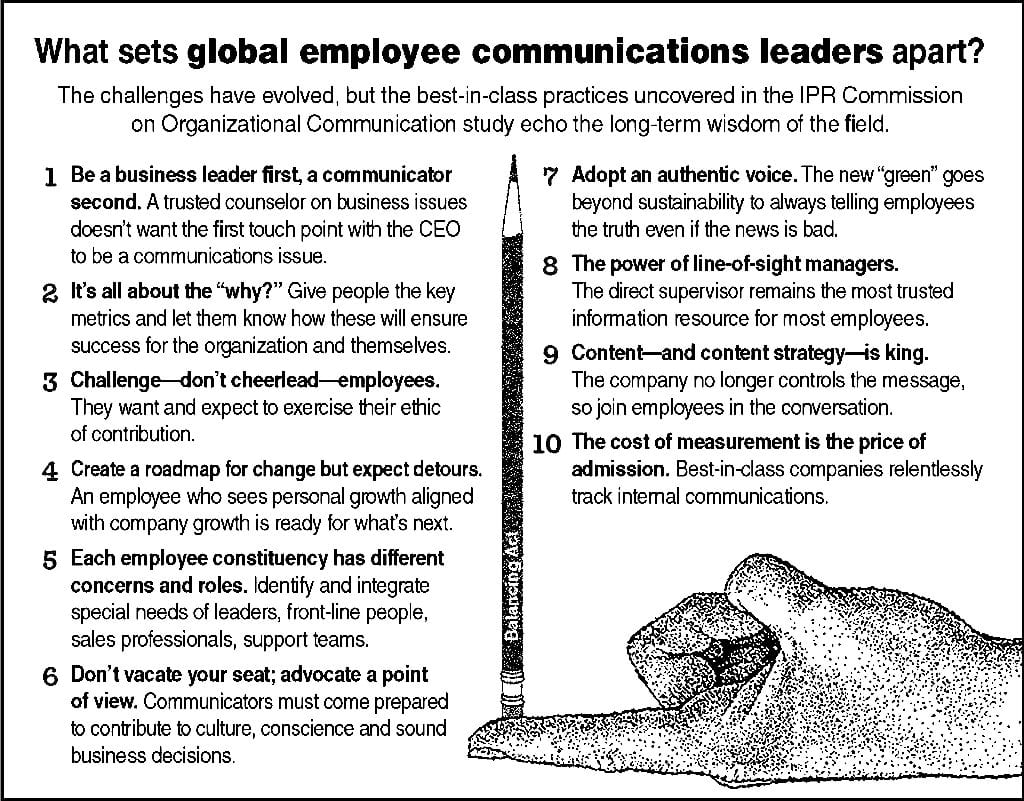
It’s more complicated than ever to provide the information that employees need to know. New research from Gallup tells us that there are a lot of “zombies” in the work force. According to Gallup, 70% of employees are emotionally disconnected at work while 20% are so disengaged that they spread discontent to other employees and customers.
Another study, just released by the Institute for Public Relations (IPR) Commission on Organizational Communication, examines what leading global companies are doing in their employee communications programs to address such challenges. This qualitative study, “Best-in-Class Practices in Employee Communications: Through the Lens of 10 Global Leaders,” conducted for the commission by KRC Research, is based on in-depth interviews with internal communications executives at 10 global companies.
The one-hour phone interviews were conducted in late 2012 and early 2013.
The companies in the study (Cargill, Chevron, FedEx, GE, IBM, Johnson & Johnson, McDonald’s, Navistar Petrobras and Toyota) were selected for their global scope and effectiveness in internal communication.
Yet these internal communications chiefs do not have easy jobs. As one of the participants said, “One hundred and forty thousand people don’t have the time, energy or bandwidth to care about 75 different business units. They want...meaning and focus.” Even in a company where workers are emotionally connected, the head of internal communications acknowledged, “Our employees demand a lot.”
The organizations selected for interviews face a host of challenges that are not unique to their status as global leaders. These include structural challenges (e.g., multiple brands in matrixed organizations), workforce friction, marketplace challenges and hurdles involving language, culture and generational differences.
So how are they making the transition from newsletters and pizza parties to business strategy, acumen and analytics? The research identifies four critical factors that make these companies standout in global employee communications. The comments below are not identified with a specific company because of confidentiality issues, but the research report seeks to be as open as possible.
1. An organizational structure that connects internal communicators with the rest of the company, up and down the chain of command.
“While I’m not responsible for the strategic plan, our leaders don’t know how to give people visibility into the strategic plan, and we do,” said one respondent.
He added, “Our finance guys and our strategy guys partnered with us. In the course of one month, [we] delivered this four-hour, half-day training session to over 1,000 people…[who] now have an obligation to go and engage.”
It’s common for internal communicators to sit high in the organizational chart. They often report to the head of corporate communications or a similar position.
Larger geographic spread and number of brands influence corporate structure. Some of the research participants have responsibility at the corporate level but no direct responsibility for regional outcomes. Others have more integrated worldwide responsibilities.
2. An innate understanding that strong internal communication will have a positive return that need not be proven at every juncture.
Corporate philosophy regarding internal communications can be a major contributor to its successespecially when the executive team knows that workers who feel valued care more about the company, its leadership and the success of the business.
From one internal communications chief: “While we can’t serve the needs of every single leader directly in the organization through our own personal support, we’ve gotten very good at providing our leadership team with what they need to be disciples of communication in their own individual areas.”
3. An arsenal of tools and practices for both listening and communicating a message.
Some of the research participants consider listening to be the top piece of advice they can offer to organizations seeking to improve their approach to communicating across the company.
These best-in-class internal communicators see themselves as both the distributors and recipients of messages. Listening posts are formal and informal, traditional and groundbreaking. Take these examples:
• One company uses select employees known as “Credo Champions” as front-line listeners and communicators.
• Another company uses groups of 50 or fewer employees as “challenge teams” to test messaging and internal communication plans before rollout.
• With internal social media, listening is increasingly more digitalonline suggestion boxes, chat rooms, comment spaces and jam sessions.
• The internal communicators look for trends over time. One acknowledged that after the company got its lowest scores ever on employee engagement, “We [set up] an associate committee…and now we’re going back and addressing some of the issues…But we shouldn’t have had to get to that point.”
4. A strong commitment to keeping employees across the company informed before stories break in mass media and digital channels. The top communicators advise two corresponding actions:
• Streamline approval processes so they can quickly disseminate breaking news internally.
• Set expectations, making a public commitment to employees and conditioning the executive team to understand that the company will inform workers first.
One participant shared that a prior practice had been to simply forward press releases to employees after the news went to the media. The new practice is to explain the topic and the reason for the release, and what it means to employees.
The research participants also talked about how strong companies learn from their experiences, positive or negative. “We still have a ways to go,” said one respondent. “But the silver lining is that we have become a lot more responsive as a company.”
The results of the interviews are now providing guidance for a related survey to test the findings on a broader scale. Meanwhile, the full qualitative research report is available on the IPR website, www.instituteforpr.org. PRN
(This is the first article in a new column covering trends in employee communications.)
CONTACT:
Frank Ovaitt is president-CEO of the Institute of Public Relations. He can be reached at [email protected].
This article appeared in the July 15 issue of PR News. Subscribe to PR News today to receive weekly comprehensive coverage of the most fundamental PR topics from visual storytelling to crisis management to media training.

